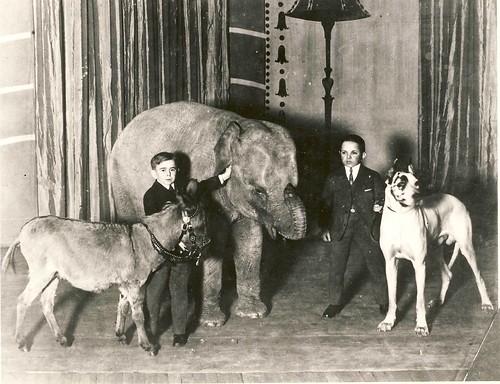| This little female was named "Mitzi" at one point this show had a Circus production number in which a midget trainer presented three small elephants "Fritzi", "Mitzi" and "Ziggy" (after Flo Ziegfeld). |
Saturday, July 05, 2008
Singer Midgets (From Buckles)
Posted by
Buckles
at
7/05/2008 05:51:00 AM
![]()
Subscribe to:
Post Comments (Atom)






7 comments:
Was this Ziggy the one with the bad reputation, who was eventually owned by Cuneo?
Someone will have to kindly refresh my memory about Ziggy, I'm nearly 50 years of age.
Roger Smith
Roger,
50? Come on, you are approacing me and Buckles in age!!
Bob Kitto
Sorry Roger, I wasn't sure what age you were talking about. Maybe you only feel 50, but some days I feel 20, but they are few and far between.
I do not know if "Ziggy" was ever owned by Cuneo. He was at the Brookfield Zoo, near Chicago, for many years, until his death. The photo of "Ziggy" almost killing Slim Lewis will never be forgotten. I would scan the picture and send it in, but my copy of "I Loved Roges" is packed away.
Buckles, do you have one you could post?
Don Bloomer
Jules Jacot told me he worked with Ziggy, and probably Mitzi and Fritzi, while they were with Singer's Midgets. I can't remember the name of Captain ? who presented the act or the year. It was between his work with the Corporation and his time in Mexico -- about mid 1930s.
Ziggy, An Elephant With Issues
Died 1975 - Chicago, Illinois
Ziggy The Elephant used to be a Chicago institution, a real-life folk tale that flowered in the '70s, then was slowly forgotten. He was ten feet tall and weighed 13,000 pounds. School kids from that time collected pennies and washed cars to build Ziggy a new and enlightened zoo enclosure. The date of his coming out into the sunshine after 29 years of being chained to a wall indoors was published by Chicago newspapers in their timelines of local history. So was the date he nearly killed his keeper.
Ziggy got his name from vaudeville impresario Flo Ziegfeld, his first US owner. Ziegfeld sold him to Singer's Midgets, who then unloaded four of their most dangerous elephants, which is how Ziggy first got to Chicago's Brookfield Zoo in the '30s. For the first year, no one at the zoo could get close enough to unchain him.
Slim Lewis, then America's foremost elephant trainer -- from the 'old school'-- was brought in to break the Asian rogue. Lewis was able to get Ziggy unchained, and for a while to participate in zoo activities. Then, on April 26, 1941, hormones high from being 'in musth,' Ziggy trunk-slapped Lewis, knocking him fifty feet, while zoo visitors looked on in horror. Before Lewis could get up, Ziggy had him by the leg, plunging his tusks down repeatedly, while Lewis, happy to be slim, rolled into the space in between them to avoid getting gored. When his tusks briefly caught deep in the dirt, Lewis managed to escape. Ziggy picked up Lewis's hat and threw it after him.
Lewis, describing Ziggy as a "devilish, wild-eyed monster," quit the zoo. For the next thirty years, Ziggy was removed from public sight, chained away inside a barn. Then, in the late '60s, the zoo got a new director, who started a PR campaign to get a new large elephant area built. Lewis was called back for an all-is-forgiven reunion event. On September 23, 1970, Lewis led a reluctant Ziggy back into the sunlight, amidst great fanfare. After forty minutes, the pachyderm turned around and went back inside
But the idea caught fire in the Windy City. Newspaper articles were written. Children held parades to benefit The Ziggy Fund. According to one account, "Billboards sprang up all over the Loop to save Ziggy and soldiers in Vietnam identified with his plight and sent money." Hundreds of thousands of dollars were raised to build a private outdoor enclosure. A book "Ziggy: The World's Greatest Elephant" was eventually written. The official coming out party was held a year later.
In March,1975, after four years of living in the new enclosure (where he was handled from a distance), Ziggy severely injured himself after falling into an eight-foot moat designed to keep him from zoo visitors. Trapped in the moat for more than a day (because no one wanted to get near him), a ramp out of the moat was created with gravel, and Ziggy walked out. But he never fully recovered, and on October 28, 1975, he died. He was 58.
The official storyline says Ziggy fell in while flirting with a female in the next enclosure. But according to Lewis in his book, "I Loved Rogues," "Stretching as far as he could, he lashed at a keeper across the moat, lost his balance and pitched in headfirst."
After he died, Ziggy slowly passed from the public's consciousness. His bones were delivered to the Field Museum in Chicago. But his pelvis was so big, at 5-feet-by-5-feet, that it wouldn't fit into a case. For a period it could be found leaning against a wall at the end of a hallway. Today they are in storage -- no photos allowed.
The name of the Captain was Charles Becker
Peter Stolk, the Netherlands
Post a Comment